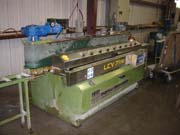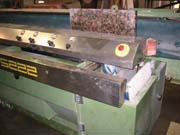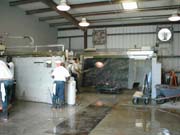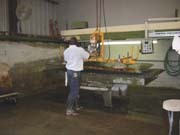
It was 1997 when the first kitchen from Stone Interiors, LLC left the company's loading docks. Back then the company had seven employees and 7,000 square feet in one facility. Since that time, annual sales have grown to $13 million, primarily from countertop fabrication - which includes more than 375 kitchens per month at its two locations. Today, the company's facilities in Loxley, AL, and Gaston, SC, total 42,000 square feet and employ some 115 workers.
While their company may have been new when they opened their Alabama facility near Mobile, president Gasper K. Naquin and his partners were hardly strangers to the stone industry. “G.K.,†as most know him, has spent 33 years in the industry and had previously owned a granite and marble business in New Orleans, LA. He is also known to many as an instructor for the Marble Institute of America's educational program. He and his partners have all been working together for 10 to 20 years. They attribute much of their success to high production made possible by efficient operations, which include tooling and machinery that they dedicate to perform specific operations.
“We like single-focused machines,†Naquin said. “I don't want a machine that can do 15 different things, because that just means 15 different problems. When you get machines that do too many things, they don't do any of them real well. Because we do volume, I want a heavy-duty machine built to do one thing that will last a long time.â€

The residential market
Because of Stone Interiors' emphasis on high-volume production - over 20,000 square feet a month - both locations run two 10-hour shifts for five days a week in their designated “machine†areas, where the large-scale machinery operates. Each location also runs another 10-hour shift in its “fabrication†areas, where hand work is done. About 85% of the company's business is residential, either going to single-family residences or to small complexes of four to six condominium units. The company produces kitchens, islands, backsplashes, bowl vanities, fireplaces, coffee tables and other products.The other 15% of the company's business is through its commercial department, and it installs around 2,000 kitchens a year. The focus of this department is multi-unit condominiums, townhouses, restaurant buffet tops and bars, as well as custom-built luxury yachts. These are not usually produced at Stone Interiors' facilities, but are purchased from other fabricators, both domestic and in such countries as Brazil, China and Spain.

A fast ROI
In each of Stone Interiors' locations, the heart of the machine area is the bridge saw. There are two in the Alabama facility and one in the South Carolina facility. All are HTO-1B models from Marmo Machinery USA. Each saw has a large cutting area of 140 x 140 inches, with a 70-foot bridge height that allows an operator access without having to bend over to walk beneath the grid. Naquin noted that his two newer saws were supplied with a hydraulic tilt table. The tables are loaded with Anver vacuum lifting equipment, and each of the saws is built to cut 10 or more slabs of granite, marble, porcelain or engineered stone per 10-hour shift. This keeps the other machines supplied for edging, shaping and other operations.For these other operations, Stone Interiors also has Marmo Meccanica equipment from Marmo Machinery USA. This includes two LCV 711 flat edge-polishing machines, an LCT 5222 and three LCT 522 vertical polishing machines for edging operations. The LCT machines are capable of seven or eight bullnose profiles at the touch of a keypad. They can also polish squared off and inclined edges as well as toroidal edges and other convex shapes. Given the company's capacity, Naquin said the equipment has had a strong return on investment (ROI), with each paying for itself in about six to eight months.
“We're getting around 50 to 55 lineal feet an hour on a full bullnose and 100 lineal feet an hour on the flat polishing edges,†Naquin said of the production rate. “These machines can do in an hour what would take a man to do in a day, and with higher quality and consistency. If a man could do 50 feet a day, he'd be a tired man. Here in our Alabama facility, we produce an average of 10 kitchens a day. And we only have five or six fabricators to do that work. There's no way we could produce even 10 kitchens a week without the equipment.â€
Naquin also said that the machinery was not “too much†equipment for the facility. “They have a small footprint, so they take up a lot less space in your shop, while they offer quality and durability,†he said. “I don't want a polisher with lots of unnecessary bells and whistles that enable you to automatically spin the piece around, turn the table around, and do a lot of unnecessary fancy things. If you have a vacuum lifter, and most of us do, it lets you turn the piece 90 degrees, and go right back through again.â€
In addition to speed, the machines offer a quality finish, explained Naquin's partner, Mark Blanda, who runs the Alabama facility along with the other partners, Lynn and Hank Mostyn, and Sales Manager Jorge Cancel. “These machines give such a perfect edge, all you really need to do is soften down the corners that come out razor sharp,†Blanda said. “Our fabricators are able to produce two or three jobs a day because the machines do the majority of the work.†In addition to softening the corners, fabricators cut bowl holes and do minor shaping.
In addition to the performance of the machinery, Naquin was also complimentary of the service his company has received from Marmo Machinery. “When we needed a machine, they got us one here in a week,†he said. “That's pretty much unheard of with any machine manufacturer in the country. Last November, one of our oldest machines went down; one we'd had in operation 20 hours a day for eight years. Marmo Machinery USA had a machine in Michigan, shipped it to us, and it was fabricating in our facility within a week. So we bought a new LCT 522 machine, had the old machine repaired, and as our capacity grew, we were able to use the older machine to do specialty edges.â€

Shop synergy
In addition to having the machines, Naquin also credits “shop synergy†for allowing a high rate of throughput. Both of the company's facilities are laid out for maximum efficiency as a workpiece moves from the front of the shop to the loading docks in the rear.After a job has been measured and the sales order written, a slab is brought into the shop and given a “cut ticket†for the saw operators. The company works both 2-cm and 3-cm material and maintains an inventory of 2,000 to 3,000 slabs. Another 20% of the slabs come from distributors around the region to fulfill special orders. In addition to granite and marble, Stone Interiors also works with limestone and engineered stone.
During the process, the saw operators cut the job, put it on a dolly, and push it to the “machine†area located a couple feet away. Workpieces are maneuvered around the facility using Anver vacuum lifting equipment. One machine is set up to run the bullnose edges and another is set up to run bevels. A third machine is the flat polisher for backsplashes and any jobs that may have just an eased edge flat polish. After polishing and edging operations, the entire job is returned to the dolly and pushed to the fabrication area to await the next available fabricator.
Next, the fabricator removes the workpieces from the dolly and lays out the whole job as it will be installed in the home. If it requires a 6-inch radius corner, for example, the fabricator does this with a router or by hand. If it requires a bowl hole, this is also cut with a router or by hand. He or she also performs a quality check and verifies the measurements.
The job is then loaded back on the dolly and moved to the installation coordinator. He assigns it to an installation crew. During the evening, 10 pick-up trucks line up at the dock, are loaded and ready to roll by morning.
Both of Stone Interiors' locations are laid out and perform much the same. The Alabama facility has grown from 7,000 square feet and seven employees. It now covers 30,000 square feet, employs 75 people, and produces some 215 kitchens a month. The new South Carolina facility has around 14,000 square feet, employs some 40 people, and produces around 160 kitchens a month. It was built in 2002 near Columbia and is headed by partners Duane Naquin and Allan Gowans.



